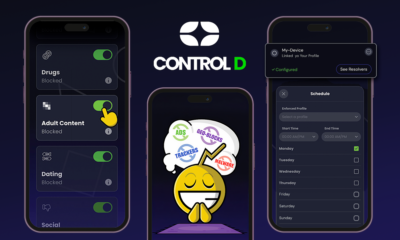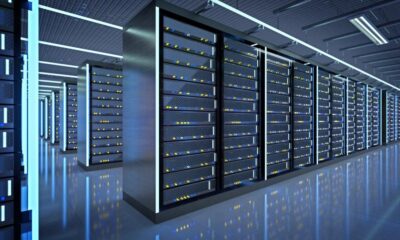TECHNOLOGY
Harnessing Multi-Cloud Computing and Federated Learning

Multi-cloud computing and federated learning are rapidly becoming the norm in enterprise technology.
The global cloud computing market is expected to reach USD 1,554.94 billion by 2030, registering a CAGR of 14.1% from 2023 to 2030, according to a new report by Grand View Research, Inc. As highlighted by UBS, it is also likely that the data universe will grow more than 10 times from 2020 to 2030, reaching 660 zettabytes—equivalent to 610 iPhones (128GB) per person.
In this age of big data, where massive volumes of information are generated at an unprecedented rate, traditional data storage and management approaches must be revised. Enterprises that wish to stay competitive need to keep up with the fast-paced digital age. Harnessing multi-cloud computing and federated learning is a symbiotic strategy that can help organizations achieve success in the phygital era. By leveraging the power of multi-cloud computing, businesses can take advantage of the strengths of different cloud providers and avoid vendor lock-in. Meanwhile, federated learning enables organizations to train machine learning models using data from multiple sources while maintaining data privacy and security. Together, these technologies can help businesses gain insights from data that was previously inaccessible, improve decision-making, and enhance overall efficiency. In this digital transformation era, embracing multi-cloud computing and federated learning is a vital step toward staying ahead of the curve.
This era demands innovative solutions to not only store and manage data, but also derive meaningful insights from it. The fusion of multi-cloud computing and federated learning is a novel approach to meeting these modern data challenges.
Multi-Cloud Computing Benefits
Redundancy and Resilience: Multi-cloud computing offers redundancy, ensuring data availability even if one cloud provider experiences an outage. Thereby it enhances the overall reliability of data storage and processing.
Cost Optimization: Organizations can leverage multiple cloud providers to choose cost-effective services and optimize their cloud spending. This benefit is crucial in a time when cost-efficiency is a top priority.
Flexibility and Vendor Lock-In Mitigation: Multi-cloud provides the flexibility to select the best tools and services for specific tasks, reducing dependency on a single vendor. This freedom mitigates the risks associated with vendor lock-in.
Improved Performance: By distributing workloads across multiple cloud providers with data centers in various locations, multi-cloud can improve data access and processing performance.
Compliance and Data Sovereignty: Multi-cloud allows organizations to select cloud providers that comply with specific regulatory requirements and store data in regions that align with data sovereignty demands.
Federated Learning Benefits
Data Privacy: Federated learning enables machine learning model training on decentralized data, preserving data privacy. This enhanced privacy is crucial for gaining or maintaining the trust of key stakeholders.
Improved Model Accuracy: By aggregating knowledge from diverse data sources, federated learning leads to more accurate machine learning models. This can be invaluable for extracting valuable insights from massive data.
Reduced Data Transfer: Federated learning minimizes the need to transfer large datasets to a central location for training, saving on bandwidth and reducing latency.
Scalability: Federated learning can scale model training across a distributed network of devices or cloud environments, making it suitable for handling the massive data generated today.
Multi-Cloud Computing Challenges
Complexity: Managing multiple cloud providers, each with its tools and interfaces, can be complex, requiring skilled personnel and robust management tools.
Security Concerns Coordinating security measures across multiple clouds can be challenging, increasing the risk of data breaches and security vulnerabilities.
Data Integration: Ensuring seamless data integration and interoperability between different cloud platforms is a significant challenge.
Cost Management: While multi-cloud can optimize costs, it can lead to cost sprawl if not carefully managed. Tracking expenses across multiple providers can be challenging.
Federated Learning Challenges
Data Fragmentation: Federated learning may face challenges when dealing with data fragmentation across multiple locations or devices, making it essential to ensure data coordination.
Security and Compliance: Coordinating security measures and compliance requirements across different federated learning nodes and cloud providers can be complex and introduce vulnerabilities.
Resource Allocation: Properly balancing resources and workloads across federated learning nodes and multi-cloud environments is essential for efficient model training.
Operational Complexity: Managing a federated learning infrastructure that spans multiple cloud providers adds operational complexity, requiring expertise in multi-cloud and federated learning principles.
Future Directions
The fusion of multi-cloud computing and federated learning holds immense promise in the deployment of smart cities, as this potent duo can handle and analyze vast data streams generated by IoT and IIoT devices, improving urban planning, resource allocation, and public services. For nascent immersive ecosystems like the evolving Metaverse as defined by Accenture and the industrial Omniverse™ powered by NVIDIA , multi-cloud and federated learning can act as a catalyst for accelerating adoption.
Conclusion
As we navigate the data-rich landscape of the phygital era, the fusion of multi-cloud computing and federated learning presents a compelling solution to the complex challenges of the digital economy and rising new economies, for example, the creator economy as highlighted by Forbes and the net-zero economy. It offers the benefits of redundancy, cost optimization, flexibility, privacy, and risk mitigation while simultaneously addressing challenges of complexity, security, and data integration. This dynamic combination is poised to play a pivotal role in shaping smart cities, metaverse platforms, and the industrial omniverse, demonstrating its potential to revolutionize how we store, manage, and extract value from data in our increasingly interconnected phygital world.
TECHNOLOGY
Next-gen chips, Amazon Q, and speedy S3

AWS re:Invent, which has been taking place from November 27 and runs to December 1, has had its usual plethora of announcements: a total of 21 at time of print.
Perhaps not surprisingly, given the huge potential impact of generative AI – ChatGPT officially turns one year old today – a lot of focus has been on the AI side for AWS’ announcements, including a major partnership inked with NVIDIA across infrastructure, software, and services.
Yet there has been plenty more announced at the Las Vegas jamboree besides. Here, CloudTech rounds up the best of the rest:
Next-generation chips
This was the other major AI-focused announcement at re:Invent: the launch of two new chips, AWS Graviton4 and AWS Trainium2, for training and running AI and machine learning (ML) models, among other customer workloads. Graviton4 shapes up against its predecessor with 30% better compute performance, 50% more cores and 75% more memory bandwidth, while Trainium2 delivers up to four times faster training than before and will be able to be deployed in EC2 UltraClusters of up to 100,000 chips.
The EC2 UltraClusters are designed to ‘deliver the highest performance, most energy efficient AI model training infrastructure in the cloud’, as AWS puts it. With it, customers will be able to train large language models in ‘a fraction of the time’, as well as double energy efficiency.
As ever, AWS offers customers who are already utilising these tools. Databricks, Epic and SAP are among the companies cited as using the new AWS-designed chips.
Zero-ETL integrations
AWS announced new Amazon Aurora PostgreSQL, Amazon DynamoDB, and Amazon Relational Database Services (Amazon RDS) for MySQL integrations with Amazon Redshift, AWS’ cloud data warehouse. The zero-ETL integrations – eliminating the need to build ETL (extract, transform, load) data pipelines – make it easier to connect and analyse transactional data across various relational and non-relational databases in Amazon Redshift.
A simple example of how zero-ETL functions can be seen is in a hypothetical company which stores transactional data – time of transaction, items bought, where the transaction occurred – in a relational database, but use another analytics tool to analyse data in a non-relational database. To connect it all up, companies would previously have to construct ETL data pipelines which are a time and money sink.
The latest integrations “build on AWS’s zero-ETL foundation… so customers can quickly and easily connect all of their data, no matter where it lives,” the company said.
Amazon S3 Express One Zone
AWS announced the general availability of Amazon S3 Express One Zone, a new storage class purpose-built for customers’ most frequently-accessed data. Data access speed is up to 10 times faster and request costs up to 50% lower than standard S3. Companies can also opt to collocate their Amazon S3 Express One Zone data in the same availability zone as their compute resources.
Companies and partners who are using Amazon S3 Express One Zone include ChaosSearch, Cloudera, and Pinterest.
Amazon Q
A new product, and an interesting pivot, again with generative AI at its core. Amazon Q was announced as a ‘new type of generative AI-powered assistant’ which can be tailored to a customer’s business. “Customers can get fast, relevant answers to pressing questions, generate content, and take actions – all informed by a customer’s information repositories, code, and enterprise systems,” AWS added. The service also can assist companies building on AWS, as well as companies using AWS applications for business intelligence, contact centres, and supply chain management.
Customers cited as early adopters include Accenture, BMW and Wunderkind.
Want to learn more about cybersecurity and the cloud from industry leaders? Check out Cyber Security & Cloud Expo taking place in Amsterdam, California, and London. Explore other upcoming enterprise technology events and webinars powered by TechForge here.
TECHNOLOGY
HCLTech and Cisco create collaborative hybrid workplaces

Digital comms specialist Cisco and global tech firm HCLTech have teamed up to launch Meeting-Rooms-as-a-Service (MRaaS).
Available on a subscription model, this solution modernises legacy meeting rooms and enables users to join meetings from any meeting solution provider using Webex devices.
The MRaaS solution helps enterprises simplify the design, implementation and maintenance of integrated meeting rooms, enabling seamless collaboration for their globally distributed hybrid workforces.
Rakshit Ghura, senior VP and Global head of digital workplace services, HCLTech, said: “MRaaS combines our consulting and managed services expertise with Cisco’s proficiency in Webex devices to change the way employees conceptualise, organise and interact in a collaborative environment for a modern hybrid work model.
“The common vision of our partnership is to elevate the collaboration experience at work and drive productivity through modern meeting rooms.”
Alexandra Zagury, VP of partner managed and as-a-Service Sales at Cisco, said: “Our partnership with HCLTech helps our clients transform their offices through cost-effective managed services that support the ongoing evolution of workspaces.
“As we reimagine the modern office, we are making it easier to support collaboration and productivity among workers, whether they are in the office or elsewhere.”
Cisco’s Webex collaboration devices harness the power of artificial intelligence to offer intuitive, seamless collaboration experiences, enabling meeting rooms with smart features such as meeting zones, intelligent people framing, optimised attendee audio and background noise removal, among others.
Want to learn more about cybersecurity and the cloud from industry leaders? Check out Cyber Security & Cloud Expo taking place in Amsterdam, California, and London. Explore other upcoming enterprise technology events and webinars powered by TechForge here.
TECHNOLOGY
Canonical releases low-touch private cloud MicroCloud

Canonical has announced the general availability of MicroCloud, a low-touch, open source cloud solution. MicroCloud is part of Canonical’s growing cloud infrastructure portfolio.
It is purpose-built for scalable clusters and edge deployments for all types of enterprises. It is designed with simplicity, security and automation in mind, minimising the time and effort to both deploy and maintain it. Conveniently, enterprise support for MicroCloud is offered as part of Canonical’s Ubuntu Pro subscription, with several support tiers available, and priced per node.
MicroClouds are optimised for repeatable and reliable remote deployments. A single command initiates the orchestration and clustering of various components with minimal involvement by the user, resulting in a fully functional cloud within minutes. This simplified deployment process significantly reduces the barrier to entry, putting a production-grade cloud at everyone’s fingertips.
Juan Manuel Ventura, head of architectures & technologies at Spindox, said: “Cloud computing is not only about technology, it’s the beating heart of any modern industrial transformation, driving agility and innovation. Our mission is to provide our customers with the most effective ways to innovate and bring value; having a complexity-free cloud infrastructure is one important piece of that puzzle. With MicroCloud, the focus shifts away from struggling with cloud operations to solving real business challenges” says
In addition to seamless deployment, MicroCloud prioritises security and ease of maintenance. All MicroCloud components are built with strict confinement for increased security, with over-the-air transactional updates that preserve data and roll back on errors automatically. Upgrades to newer versions are handled automatically and without downtime, with the mechanisms to hold or schedule them as needed.
With this approach, MicroCloud caters to both on-premise clouds but also edge deployments at remote locations, allowing organisations to use the same infrastructure primitives and services wherever they are needed. It is suitable for business-in-branch office locations or industrial use inside a factory, as well as distributed locations where the focus is on replicability and unattended operations.
Cedric Gegout, VP of product at Canonical, said: “As data becomes more distributed, the infrastructure has to follow. Cloud computing is now distributed, spanning across data centres, far and near edge computing appliances. MicroCloud is our answer to that.
“By packaging known infrastructure primitives in a portable and unattended way, we are delivering a simpler, more prescriptive cloud experience that makes zero-ops a reality for many Industries.“
MicroCloud’s lightweight architecture makes it usable on both commodity and high-end hardware, with several ways to further reduce its footprint depending on your workload needs. In addition to the standard Ubuntu Server or Desktop, MicroClouds can be run on Ubuntu Core – a lightweight OS optimised for the edge. With Ubuntu Core, MicroClouds are a perfect solution for far-edge locations with limited computing capabilities. Users can choose to run their workloads using Kubernetes or via system containers. System containers based on LXD behave similarly to traditional VMs but consume fewer resources while providing bare-metal performance.
Coupled with Canonical’s Ubuntu Pro + Support subscription, MicroCloud users can benefit from an enterprise-grade open source cloud solution that is fully supported and with better economics. An Ubuntu Pro subscription offers security maintenance for the broadest collection of open-source software available from a single vendor today. It covers over 30k packages with a consistent security maintenance commitment, and additional features such as kernel livepatch, systems management at scale, certified compliance and hardening profiles enabling easy adoption for enterprises. With per-node pricing and no hidden fees, customers can rest assured that their environment is secure and supported without the expensive price tag typically associated with cloud solutions.
Want to learn more about cybersecurity and the cloud from industry leaders? Check out Cyber Security & Cloud Expo taking place in Amsterdam, California, and London. Explore other upcoming enterprise technology events and webinars powered by TechForge here.
-

 WORDPRESS7 days ago
WORDPRESS7 days ago7 Best WooCommerce Points and Rewards Plugins (Free & Paid)
-

 MARKETING7 days ago
MARKETING7 days agoBattling for Attention in the 2024 Election Year Media Frenzy
-

 WORDPRESS6 days ago
WORDPRESS6 days ago13 Best HubSpot Alternatives for 2024 (Free + Paid)
-

 MARKETING6 days ago
MARKETING6 days agoAdvertising in local markets: A playbook for success
-

 SEO7 days ago
SEO7 days agoGoogle Answers Whether Having Two Sites Affects Rankings
-

 SEARCHENGINES6 days ago
SEARCHENGINES6 days agoGoogle Core Update Flux, AdSense Ad Intent, California Link Tax & More
-

 AFFILIATE MARKETING7 days ago
AFFILIATE MARKETING7 days agoGrab Microsoft Project Professional 2021 for $20 During This Flash Sale
-

 PPC4 days ago
PPC4 days ago10 Most Effective Franchise Marketing Strategies













